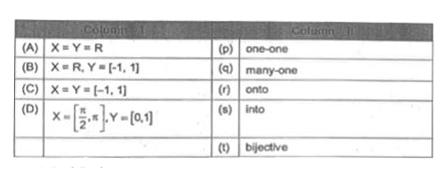Let A={x,y,z}=B={u,v,w)andf:A→B be defined by f (x)=u,f(y)=v,f(z)=w. Then, f is
surjective but not injective
injective but not surjective
bijective
none of these
The correct Answer is:C
To determine the nature of the function f:A→B defined by f(x)=u,f(y)=v,f(z)=w, we need to analyze whether it is injective (one-to-one), surjective (onto), or both (bijective).
1. Identify the Sets and Function:
- Let A={x,y,z}
- Let B={u,v,w}
- The function f is defined as:
- f(x)=u
- f(y)=v
- f(z)=w
2. Check for Injectivity:
- A function is injective if different elements in the domain map to different elements in the codomain.
- Here, we see:
- f(x)=u
- f(y)=v
- f(z)=w
- Since x,y,z are distinct and map to distinct u,v,w, the function is injective.
3. Check for Surjectivity:
- A function is surjective if every element in the codomain has a pre-image in the domain.
- The codomain B consists of u,v,w.
- From the function definitions:
- u has pre-image x
- v has pre-image y
- w has pre-image z
- Since every element in B is covered by the mapping from A, the function is surjective.
4. Conclusion:
- Since the function f is both injective and surjective, it is bijective.
Final Answer:
The function f is bijective.
- Let A={x,y,z}
- Let B={u,v,w}
- The function f is defined as:
- f(x)=u
- f(y)=v
- f(z)=w
- A function is injective if different elements in the domain map to different elements in the codomain.
- Here, we see:
- f(x)=u
- f(y)=v
- f(z)=w
- Since x,y,z are distinct and map to distinct u,v,w, the function is injective.
- A function is surjective if every element in the codomain has a pre-image in the domain.
- The codomain B consists of u,v,w.
- From the function definitions:
- u has pre-image x
- v has pre-image y
- w has pre-image z
- Since every element in B is covered by the mapping from A, the function is surjective.
- Since the function f is both injective and surjective, it is bijective.
The function f is bijective.
Topper's Solved these Questions
- FUNCTIONSBOOK - OBJECTIVE RD SHARMA ENGLISHCHAPTER - FUNCTIONSEXERCISE - Chapter Test
29 Videos
- FUNCTIONSBOOK - OBJECTIVE RD SHARMA ENGLISHCHAPTER - FUNCTIONSEXERCISE - Section II - Assertion Reason Type
10 Videos
- DISCRETE PROBABILITY DISTRIBUTIONSBOOK - OBJECTIVE RD SHARMA ENGLISHCHAPTER - DISCRETE PROBABILITY DISTRIBUTIONSEXERCISE - Exercise
40 Videos
- HYPERBOLABOOK - OBJECTIVE RD SHARMA ENGLISHCHAPTER - HYPERBOLAEXERCISE - Chapter Test
29 Videos
Similar Questions
Let A = {x, y, z), B = {u, v, w} and f : A → B be defined by f(x) = u,
f(y) = v, f(z) = w. Then, f is
View SolutionLet A=R−{3},B=R−{1}, and let f:A→B be defined by f(x)=x−2x−3 is f invertible? Explain.
View SolutionIf f:Z→Z be given by f(x)=x2+ax+b, Then,
View SolutionLet f:X→Y be a function defined by f(x)=sinx.

View SolutionIf for all x,y the function f is defined by f(x)+f(y)+f(x).f(y)=andf(x)>0. Then show f'(x)=0 when f'(x)=0 is differentiable.
View SolutionLet A={a, b, c} , B={u v, w} and let f and g be two functions from A to B and from B to A respectively defined as: f={(a, v), (b, u), (c, w)} , g={(u, b), (v, a), (w, c)}. Show that f and g both are bijections and find fog and gof.
View SolutionLet f:Z→Z be defined by f(x)=x+2. Find g:Z→Z such that gof=IZ .
View SolutionLet f:Z→Z be defined by f(x)=x+2. Find g:Z→Z such that gof=IZ .
View SolutionLet f={(1,1),(2,3),(0,1),(1,3)}be a function from Z→Z defined by f(x)=ax+b, for some integers a,b.
Determine a,b.
View SolutionLet a,b,c be rational numbers and f:Z→Z be a function given by f(x)=ax2+bx+c. Then, a+b is
View Solution
